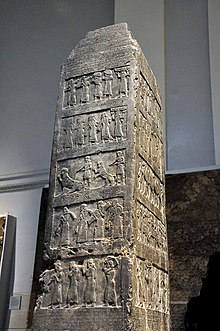Shalmaneser III
| Shalmaneser III | |
|---|---|
| |
 Shalmaneser III, on the Throne Dais of Shalmaneser III at the Iraq Museum. | |
| King of the Neo-Assyrian Empire | |
| Reign | 859–824 BC |
| Predecessor | Ashurnasirpal II |
| Successor | Shamshi-Adad V |
| Born | 893-891 BC |
| Died | c. 824 BC |
| Father | Ashurnasirpal II |
| Mother | Mullissu-mukannishat-Ninua (?) |
Shalmaneser III (Šulmānu-ašarēdu, "the god Shulmanu is pre-eminent") was king of the Neo-Assyrian Empire from the death of his father Ashurnasirpal II in 859 BC to his own death in 824 BC.[1]
His long reign was a constant series of campaigns against the eastern tribes, the
Reign

Campaigns
Shalmaneser began a campaign against
In 851 BC, following a rebellion in Babylon, Shalmaneser led a campaign against Marduk-bēl-ušate, younger brother of the king,
In the eighth year of my reign, Marduk-bêl-usâte, the younger brother, revolted against Marduk-zâkir-šumi, king of Karduniaš, and they divided the land in its entirety. In order to avenge Marduk-zâkir-šumi, I marched out and captured Mê-Turnat. In the ninth year of my reign, I marched against Akkad a second time. I besieged Ganannate. As for Marduk-bêl-usâte, the terrifying splendor of Assur and Marduk overcame him and he went up into the mountains to save his life. I pursued him. I cut down with the sword Marduk-bêl-usâte and the rebel army officers who were with him.
— Shalmaneser III, Black Obelisk[i 1]
Against Israel

In 841 BC, Shalmaneser campaigned against Hadadezer's successor
Against Tibareni
In 836 BC, Shalmaneser sent an expedition against the Tibareni (
Later campaigns

Despite the rebellion later in his reign, Shalmanesar had proven capable of expanding the frontiers of the Neo-Assyrian Empire, stabilising its hold over the Khabur and mountainous frontier region of the Zagros, contested with Urartu.
In Biblical studies
His reign is significant to
Construction and the Black Obelisk

He had built a palace at
The Black Obelisk is a significant artifact from his reign. It is a black
The second
"The tribute of Jehu, son of Omri: I received from him silver, gold, a golden bowl, a golden vase with pointed bottom, golden tumblers, golden buckets, tin, a staff for a king [and] spears."[10]
It was erected as a public monument in 825 BC at a time of civil war. It was discovered by archaeologist Sir Austen Henry Layard in 1846.
Gallery
-
Statue of Shalmaneser III at Istanbul Archaeological Museums
-
Statue of Shalmaneser III from Nimrud, Iraq Museum
-
Kurba'il Statue of Shalmaneser III from Fort Shalmaneser, Iraq Museum
-
Shalmaneser III, detail of glazed wall panel from Fort Shalmaneser, Iraq Museum
-
Throne dais of Shalmaneser III from Fort Shalmaneser, Iraq Museum
-
Unfinished basalt statue of Shalmaneser III, from Assur, Iraq. Ancient Orient Museum, Istanbul
-
The upper end of the Black Obelisk of Shalmaneser III, from Nimrud, the British Museum
-
Black Obelisk of Shalmaneser III, the British Museum
-
Throne dais of Shalmaneser III, Royal reception
-
Throne dais of Shalmaneser III, procession
-
Statue of the Assyrian king Shalmaneser III at the Iraq Museum in Baghdad
-
Shalmaneser III, detail, North Face, East End, Throne Dais of Shalmaneser III from Nimrud, Iraq
-
Shalmaneser III, detail, south face, west end, Throne Dais of Shalmaneser III from Nimrud, Iraq
-
Kurba'il Statue of Shalmaneser III at the Iraq Museum in Baghdad
-
Shulmano Osser the third , the great king The strong king , king of the world , king of the country Assyria Son of the Ashour Nassir Abli ( the second ) , king of the country Assyria Son of Toklty Ninorta ( the second ) king of the world king of the country Assyria Building a Ziqqurat King of kilkho city ... cuneiform writings on the bricks of King Shalmaneser III in Erbil Civilization Museum
See also
- List of artifacts significant to the Bible
- Black Obelisk of Shalmaneser III
- Short chronology timeline
Notes
- ^ Black Obelisk, BM WAA 118885, crafted c. 827 BC, lines 73–84
References
- ^ "Black Obelisk of Shalmaneser II". Mcadams.posc.mu.edu. Retrieved 26 October 2012.
- ISBN 9789004347588.
- ^ Jean Jacques Glassner, Mesopotamian Chronicles, Atlanta 2004,
- ISBN 978-1-4982-8143-0.
- ISBN 978-1-58465-817-7.
- ISBN 978-0-19-100293-9.
- ISBN 978-0-19-923147-8.
- ^ Georges Roux - Ancient Iraq
- ^ "In 836 Shalmaneser made an expedition against the Tibareni (Tabal) which was followed by one against Cappadocia" in Chisholm, Hugh; Garvin, James Louis (1926). The Encyclopædia Britannica: A Dictionary of Arts, Sciences, Literature & General Information. Encyclopædia Britannica Company, Limited. p. 798.
- ^ ISBN 978-1-58465-817-7.
- ISBN 978-1-58465-817-7.
- ISBN 978-1-4982-8143-0.
Sources
- This article incorporates text from a publication now in the public domain: Chisholm, Hugh, ed. (1911). "Shalmaneser". Encyclopædia Britannica. Vol. 24 (11th ed.). Cambridge University Press.
Further reading
- Kirk Grayson, A. (1996). Assyrian Rulers of the Early First Millennium BC (858-754 BC). University of Toronto press.
External links
![]() Media related to Shalmaneser III at Wikimedia Commons
Media related to Shalmaneser III at Wikimedia Commons















